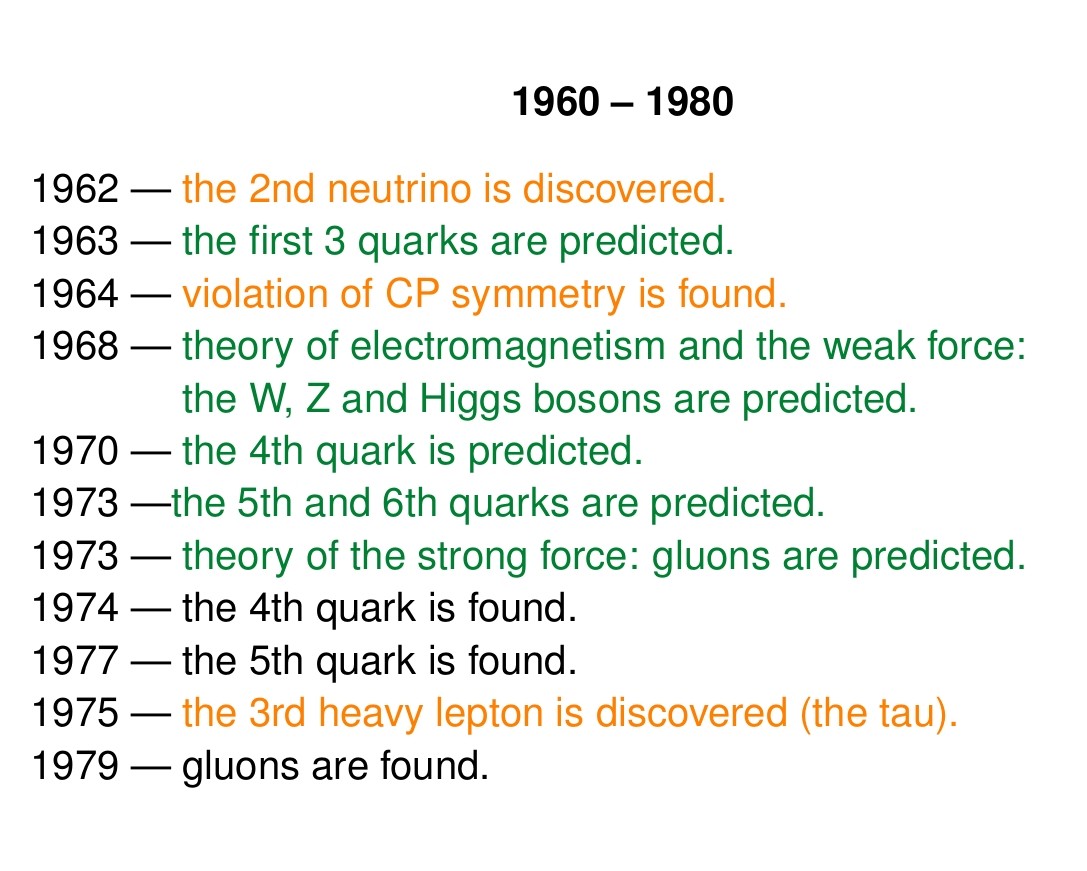John Carlos Baez on Nostr: The period from 1960 to 1980 was the heyday of particle physics! This is when I was a ...
The period from 1960 to 1980 was the heyday of particle physics! This is when I was a kid, so you can see I wanted to work on fundamental physics.
There was a thrilling interplay of theory and experiment. There were plenty of experimental surprises that were later fit into the Standard Model (in yellow), but also brand-new theories, now parts of the Standard Model, that were later confirmed by experiment (in green).
The 2nd neutrino came as a surprise, but the first 3 quarks were predicted to exist, by Gell-Mann, Zweig and others, based on data about the zoo of particles (made of quarks) that were being discovered. Electromagnetism was unified with the weak nuclear force in a theory that predicted the W, Z and Higgs bosons. Then 3 more quarks were predicte - and people came up with a theory of the strong nuclear force that holds together quarks, saying that it's carried by bosons of its own, jokingly called gluons.
The biggest experimental surprise in this era is the discovery that not only is left different from right, the world also change if you could switch left and right while switching matter and antimatter. This is called the violation of CP symmetry. This too is now a key part of the Standard Model.
You'll notice that, despite all this excitement, physicists were starting to probe realms very far from everyday human experience. Unlike work down in the first half of the century, it's hard to use these theories to build new technologies. The low-hanging fruit had already been picked when it comes to finding new fundamental laws. By this time, most physics was about *applying* the laws we already knew.
(5/n)

There was a thrilling interplay of theory and experiment. There were plenty of experimental surprises that were later fit into the Standard Model (in yellow), but also brand-new theories, now parts of the Standard Model, that were later confirmed by experiment (in green).
The 2nd neutrino came as a surprise, but the first 3 quarks were predicted to exist, by Gell-Mann, Zweig and others, based on data about the zoo of particles (made of quarks) that were being discovered. Electromagnetism was unified with the weak nuclear force in a theory that predicted the W, Z and Higgs bosons. Then 3 more quarks were predicte - and people came up with a theory of the strong nuclear force that holds together quarks, saying that it's carried by bosons of its own, jokingly called gluons.
The biggest experimental surprise in this era is the discovery that not only is left different from right, the world also change if you could switch left and right while switching matter and antimatter. This is called the violation of CP symmetry. This too is now a key part of the Standard Model.
You'll notice that, despite all this excitement, physicists were starting to probe realms very far from everyday human experience. Unlike work down in the first half of the century, it's hard to use these theories to build new technologies. The low-hanging fruit had already been picked when it comes to finding new fundamental laws. By this time, most physics was about *applying* the laws we already knew.
(5/n)
